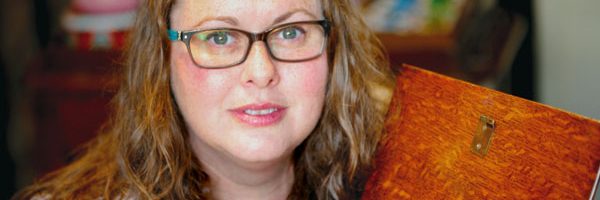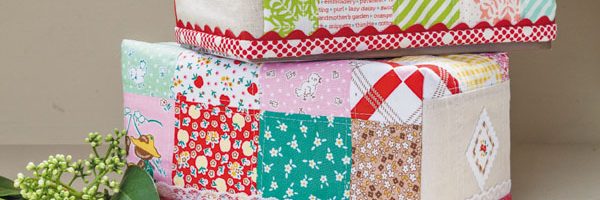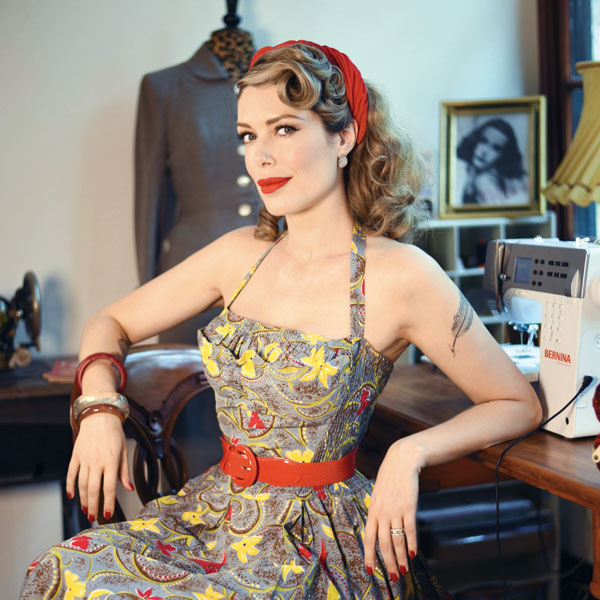
Get to know author, writer, producer and now STITCHER – Tara Moss
TARA MOSS: Author, Human rights advocate, Documentary presenter, writer and producer, Vintage lover, Doctoral Candidate at the University of Sydney, Journalist, Charity worker, Blogger and now… STITCHER
There’s not a lot of downtime in Tara Moss’s schedule, but what little there is now taken up with her new-found passion – sewing. And in typical form, she brings her own distinctive high style to the craft, with a definite vintage edge.

Q: Did you sew as a child?
A: No. I took up sewing in 2016, after setting my mind to learning. It is a vital life skill, but one I lacked. I am a total newbie.
Q: Any home-economics stitching classes at school?
A:I remember something about sewing a denim bag in high school for a home-economics class. I think it was the first and only time I sewed anything until 2016. I don’t think it was a great experience at the time. My late mother was wonderful, though, and created our Halloween costumes and more. She was very crafty. I wish I’d taken it up with her when I was little.
Q: Why did you decide to learn to sew as an adult?
A: With time, it became clear to me that I was lacking an important life skill. I didn’t sew and didn’t even feel comfortable sewing on buttons. Sure, I had to sometimes try, but I had no idea what I was doing, and they often fell off again.
I often needed alterations, hemming or mending and I couldn’t do it myself. It was well and truly time to become more self-sufficient, so I wanted to learn how to alter and mend my clothes and I also wanted to be able to make things for myself and for other people.
I wanted to make things with quality and care and didn’t want to be restricted by what was available in commercial stores, creatively or otherwise.
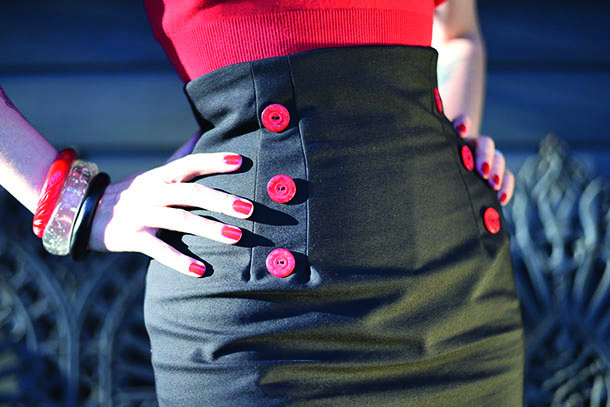
Q:Did you have any stitching calamities when you first started?
A: I spent a very long time on a vintage bolero pattern that I basically want to burn now. It was the wrong size so graded it, did two toiles, and spent a long time on the sewing, and it turned out horribly. It’s my only disaster so far, but I did learn a lot.
It was one of those old 1950s vintage patterns where the notches don’t line up and you love the illustration on the front but it just doesn’t pan out.
Learn demystifying machine appliqué with Anne Sommerlad
Q: Are you sorry you didn’t learn earlier?
A: There are many things I could have done better or earlier, but I have lived a very full life so far and I don’t believe in regrets.
Q: What have you made since you felt comfortable with the craft?
A: My first project was a Neo-Victorian skirt, and I’ve since made a standard cushion (good practice), a brooch holder, a circle skirt, a pencil skirt, a deconstructed steampunk ensemble, a fox backpack for my daughter, a Christmas dress for her, a Victorian corset and more. I have also altered or added to a lot of my existing clothes.
Q: How does sewing make you feel more self-sufficient?
A: It’s an important life skill I think every person should possess. You can cut down on a lot of waste if you better understand fabric and clothes, choose more carefully when you buy, and mend or alter what you have to suit you, your personality and your life.
It brings great pleasure, as well. I want to feel connected with the things I cover my body with and live in.
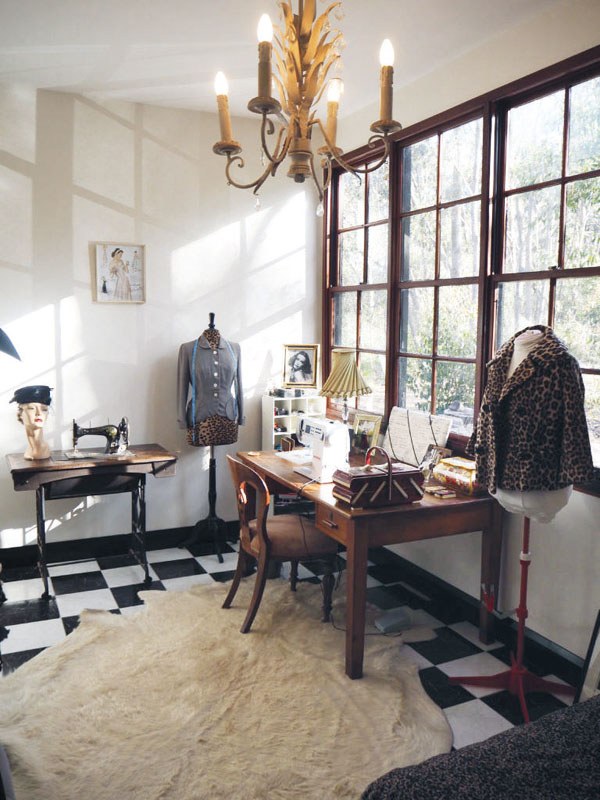
Q: Was your prime motivation fashion, self-sufficiency, environmental concerns or financial?
A: My primary motivations were all of the above, but also fit. I am unusually tall and have a large hip spring that is not found in standard modern clothes or patterns (14-16 inches), so I end up needing a lot of alterations.
I started my sewing by doing alterations to my existing clothing, as well as mending my vintage clothes, and then I began to make new pieces from scratch. I remain passionate about adapting and saving old pieces, as well as creating new ones.
Because I love and wear mid-century vintage, mending skills are invaluable. The clothes are built to last, but thread can become worn or zippers can need replacing.
Make a quilt using precut fabrics and learn how to quilt-as-you-go! with Michelle Marvig
Q: You made a very good point when you said “It is ironic, in a way, that a feminist woman would avoid things precisely because they are considered feminine, and in doing so, become less self-sufficient.” Do you feel strongly about this angle of feminism and are there other examples of constraints set by feminism, do you think?
A: I don’t’ believe feminism itself has set any constraints – it has specifically removed previously existing legal, social and cultural constraints for women – but what we see is a long history of undervaluing and even ridiculing the ‘feminine’ and endeavours mastered by women.
None of us lives in a vacuum; we are all impacted by the culture and ideas we grow up with or witness in popular culture, so some of us who are steadfastly dedicated to gender equality and human rights will still see traditionally feminine endeavours as less important than traditionally masculine ones, even though we don’t recognise that bias. I was one of those people.
I didn’t consciously realise that I was rejecting or undervaluing some endeavours in part because they were demonised or ridiculed in popular culture as being ‘weak’, ‘feminine’ or less important. I wanted to be strong, which is a good thing, but unconsciously I saw more masculine endeavours as the strong ones, and that’s where I was wrong.
Today, when there is a wider public understanding that women can master what were culturally regarded for a long time as solely ‘masculine skills’, like leadership and business, etc (They were considered male domains, even though women still did those things, anyway!), there is still a sense of ridiculing and undervaluing things that were considered traditionally ‘feminine’, like home cooking, sewing, dressmaking, child care, etc, even though none of us could get by without those skills.
We often ridicule men who enjoy these pastimes or have these skills as being ‘feminine’, and we still often undervalue or take for granted women who master them. I’d like to see that stop.

Q: As a novice, did it take you long to make a garment?
A:I am still a novice, but enthusiastic. It probably takes me 10 times longer than the next person, but I enjoy myself. I actually began by altering garments by adding ruffles and length, then went on to simple things, like cushions and a fox backpack for my daughter, and then started making garments for myself from scratch.
I usually only have an hour or two at a time to sew, and it can take me a week or a month to finish something, depending on my work schedule. Sometimes I will be on the road a lot, or will be juggling deadlines.
Q: What was the trickiest part for you?
A: Time. But apart from my time constraints, I still struggle at times with garment construction techniques, which are not yet second nature.
This is particularly true for vintage patterns, which I love, but which are not always easy to follow. I am very comfortable with my little Bernina now, and I understand clothes, but when the pattern is cut up, I don’t yet automatically know the way it will be constructed, to achieve the best finish. I’m working on that.
Q: We at Homespun often hear from designers who say they are completely and utterly hooked on their particular stitching crafts. Have you reached that stage yet?
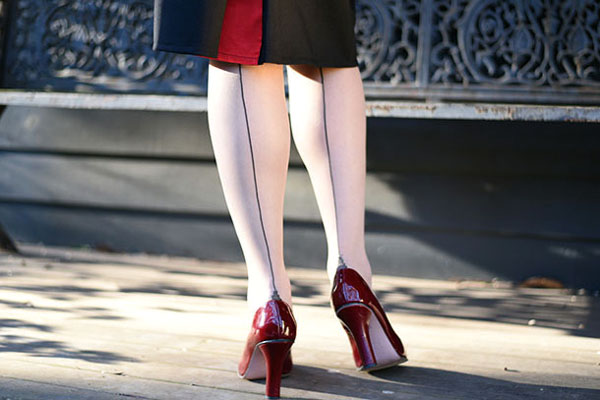
A: I am hooked on dressmaking and vintage patterns.
Q: Do you have a dedicated space for your sewing or is your machine squeezed onto the edge of your dining table?
A: I started out with a corner of the dining room table and I now have my own craft and workroom, where I write my books and VictoryLamour.com vintage blogs, sew and run my little online shop Tara Moss’s Vintage Closet, where I sell my collection of vintage and second hand clothes. Perhaps one day I will add items I’ve made.
Learn hand appliqué! with Pam Furniss
Q: Do you only sew garments or do you also like making homewares?
A: So far, I have focused mostly on clothing, with the odd cushion.
Q: Homespun features many quilt designers. Do you hanker after this, too, now that you feel confident with needle and thread?
A: I haven’t got into quilting yet, but I hear it’s addictive.
Q: What are your top priorities with sewing (design, construction, materials etc)?
A: My top priority with sewing is actually mending and maintaining vintage pieces, with a very close second being the creative design process of making new, unique, individualised clothing, perfectly fitted to the individual and their personality and body shape.
Q: You’ve also made various things for your daughter. Is sewing for a child even more enjoyable than stitching something for yourself?
A: Making something for someone you love is a beautiful thing. You are creating a memory. But I also feel that creating your own clothes is immensely satisfying. The tactile connection to the fabric and the time spent creating it adds to the value. I dislike the sense of disposable clothes and objects. Homemade clothes have memories in them and a value often earned by time and care.
I recently made a dress for Sapphira for Christmas. It was the first full dress I’d made and it’s her first homemade dress. Tara Moss loves it and it brings me joy to see her wear it.
Q: Would you list your talents in order of current priority please?
* Author
* Human rights advocate
* Documentary presenter, writer and producer
* Vintage lover
* Stitcher
* Doctoral Candidate at the University of Sydney
* Journalist
* Charity worker
My focus and work schedule changes from month to month and year to year, but at the moment, I am writing a new novel (my 12th book), working with UNICEF, Our Watch and Full Stop in an unpaid capacity as an advocate, and I am sewing and mending and producing a documentary with the ABC. I will soon be diving into my PhD again as well. I like the contrasts in my life.
TARA MOSS’s PROFESSIONAL BIOGRAPHY
Tara Moss is an author, journalist, TV documentary presenter, human rights advocate and anti-cyberbullying campaigner. Tara Moss is currently the executive producer, co-writer and host of Cyberhate, coming to ABC TV in 2017, examining the phenomenon of online abuse.
Since 1999, Tara Moss has written 11 bestselling books, published in 19 countries and 13 languages, including the acclaimed Mak Vanderwall crime fiction series and the Pandora English paranormal series.
Her first non-fiction book, the critically acclaimed The Fictional Woman, was published in 2014 and became a number one national non-fiction bestseller, and her iconic cover design, featuring her face labelled with ‘fictions’ or stereotypes about women won Best Non-Fiction Book Design at the Australia Book Design Awards in 2015 with HarperCollins Publishers.
She is a PhD Candidate at the University of Sydney, and has earned her private investigator credentials (Cert III) from the Australian Security Academy. Her latest book is Speaking Out: A 21st Century Handbook for Women and Girls. Her next fiction novel is due for release in 2018.
Moss is an outspoken advocate for the rights of women and children. Tara Moss has been a UNICEF Goodwill Ambassador since 2007 and as of 2013 is UNICEF Australia’s National Ambassador for Child Survival, and has visited Australian hospitals, maternity wards and schools as well as Syrian refugee camps in Lebanon in her UNICEF role.
Moss has spoken at numerous schools on cyberbullying and online child safety, and in July 2015 was announced as the Norton Family Ambassador on these issues. In 2015 she was announced as Patron of the Full Stop Foundation for Rape & Domestic Violence Services Australia and launched the foundation at Parliament House, and in 2016 she was named an ambassador for Our Watch. In 2015 she received an Edna Ryan Award for her significant contribution to feminist debate, speaking out for women and children and inspiring others to challenge the status quo.
Her in-depth novel research has seen her tour the FBI Academy at Quantico, spend time in squad cars, morgues, prisons, the Hare Psychopathy Lab, the Supreme Court and criminology conferences, take polygraph tests, shoot weapons, conduct surveillance, pass the Firearms Training Simulator (FATSII) with the LAPD, pull 4.2 G’s doing loops over the Sydney Opera House flying with the RAAF, and acquire her CAMS race driver licence.
Tara Moss has hosted the true crime documentary series Tough Nuts – Australia’s Hardest Criminals on the Crime & Investigation Network, ‘Tara Moss Investigates’ on the National Geographic Channel and the author interview show Tara Moss in Conversation on 13th Street Universal. In 2014 she was recognised for Outstanding Advocacy for her blog Manus Island: An insider’s report, which helped to break information to the public about the events surrounding the alleged murder of Reza Barati inside the Australian-run Manus Island Immigration Detention Centre.
Moss also writes about vintage, sewing, craft and body positivity at her vintage-focussed blog VictoryLamour.com.
Tara Moss is a dual Australian/Canadian citizen.
Recent Awards and Accolades:
2012 Australia’s 20 Most Influential Female Voices
2013 Australia’s Most Inspiring Women ‘who push boundaries, create change and motivate’
2014 Outstanding Advocacy Award for Manus Island: An insider’s report
- Cosmo’s The Women Who Made 2014 Better for The Fictional Woman
- Influential Women of 2014, alongside Malala, Laura Bates, Angelina Jolie and more
- The Hoopla‘s The Female Eunuch Award for The Fictional Woman
2015 Best Designed Non-Fiction Book Award, for The Fictional Woman designed by Tara Moss and Matt Stanton
- Part of the University of Sydney’s Leadership for Good
- Edna Ryan Award – ‘Grand Stirrer Award’ for making a feminist difference by speaking out for women and children, for a significant contribution to feminist debate and inciting others to challenge the status quo
2016 Champion of the West award for community service
2017 Order of Lambrick Park, ‘recognizing and honouring Lambrick Park alumni who have made significant contributions or achievements since graduation.’
STITCHING CREDENTIALS
I am pleased to be the Patron of the Australian Sewing Guild. I also have the opportunity this year to create sewing video tutorials with Bernina (Sewing Vintage, victorylamour.com/sewing-vintage-tara-moss), which I really look forward to sharing.
It is my hope that through these tutorials and my Sewing Guild role as Patron, I can generate more interest in sewing and mending in the broader community, perhaps reaching people who, like myself not so long ago, found it too intimidating or didn’t know how to start.
FIND OUT MORE:
Blog: taramoss.com
‘Vintage’ blog: victorylamour.com
Bernina Sewing Vintage vlog series: victorylamour.com/sewing-vintage-tara-moss
Books: Selected bookshops or from various online outlets, such as www.booktopia.com.au/tara-moss/author9.html
Photography: Berndt Sellheim

